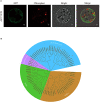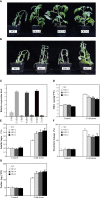Sucrose synthase gene SUS3 could enhance cold tolerance in tomato
- PMID: 38333039
- PMCID: PMC10850397
- DOI: 10.3389/fpls.2023.1324401
Sucrose synthase gene SUS3 could enhance cold tolerance in tomato
Abstract
Tomatoes are susceptible to damage from cold temperatures in all stages of growth. Therefore, it is important to identify genetic resources and genes that can enhance tomato's ability to tolerate cold. In this study, a population of 223 tomato accessions was used to identify the sensitivity or tolerance of plants to cold stress. Transcriptome analysis of these accessions revealed that SUS3, a member of the sucrose synthase gene family, was induced by cold stress. We further investigated the role of SUS3 in cold stress by overexpression (OE) and RNA interference (RNAi). Compared with the wild type, SUS3-OE lines accumulated less MDA and electrolyte leakage and more proline and soluble sugar, maintained higher activities of SOD and CAT, reduced superoxide radicals, and suffered less membrane damage under cold. Thus, our findings indicate that SUS3 plays a crucial role in the response to cold stress. This study indicates that SUS3 may serve as a direct target for genetic engineering and improvement projects, which aim to augment the cold tolerance of tomato crops.
Keywords: SUS3; cold stress; sucrose synthase; tomato; transcriptome.
Copyright © 2024 Li, Wang, Liu, Liu, Xu, Lu and Ye.
Conflict of interest statement
The authors declare that the research was conducted in the absence of any commercial or financial relationships that could be construed as a potential conflict of interest.
Figures





References
-
- Airaki M., Leterrier M., Mateos R. M., Valderrama R., Chaki M., Barroso J. B., et al. . (2012). Metabolism of reactive oxygen species and reactive nitrogen species in pepper (Capsicum annuum L.) plants under low temperature stress. Plant Cell Environ. 35, 281–295. doi: 10.1111/j.1365-3040.2011.02310.x - DOI - PubMed
-
- Al-aghabary K., Zhu Z., Shi Q. (2005). Influence of Silicon Supply on chlorophyll content, chlorophyll fluorescence, and antioxidative enzyme activities in tomato plants under salt stress. J. Plant Nutr. 27, 2101–2115 126. doi: 10.1081/PLN-200034641 - DOI
LinkOut - more resources
Full Text Sources
Miscellaneous

